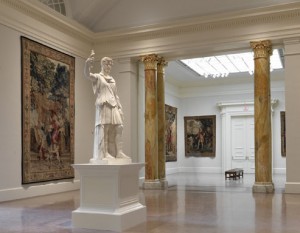
VMFA’s newly conserved Septimius Sevrus
There is a very interesting story behind Septimius Severus—both the man himself and the statue of him at VMFA. What some people don’t know is that this Roman emperor was born in Lepcis Magna, North Africa, and so was sometimes referred to as the “African Emperor.” When Severus was 18, he moved to Rome to pursue a public career, and was appointed senator by Marcus Aurelius shortly after. He later ruled as emperor from AD193 to 211, bringing stability and reform to the Roman Empire after a period of civil war. During his reign, Septimius Severus instituted many military campaigns, including a major one in North Africa, which helped to greatly expand and fortify Roman Africa.
You can now see why the statue of Septimius Severus has been placed in Tapestry Hall at VMFA. This is the hall that connects the ancient art galleries to the newly installed Africa art gallery, alluding to the emperor’s ties to both ancient Africa and ancient Rome. I think this is so clever! A lot of questions were raised by scholars about whether the statue itself was actually made in antiquity. So, in 2007, VMFA conducted extensive research on the statue and found out some very interesting information about it. It was concluded that the head and torso were made in antiquity, but belonged to two separate works of art—the head was from a statue of Septimius Severus, and the statue that the torso was from is unknown. These two statues were damaged over time, and in the 17th century, the head of Septimius Severus and the portion of the torso were combined and then added on to, completing what is now the statue of Septimius Severus that VMFA owns. Stop by Tapesty Hall and see the newly-restored statue—He’s definitely worth seeing!
-Amy Nicholas, VMFA communications intern